Jerusalem. Part 4
Description
This section is from the book "Jerusalem - John L. Stoddard's Lectures", by John L. Stoddard. Also available from Amazon: John L. Stoddard's Lectures 13 Volume Set.
Jerusalem. Part 4
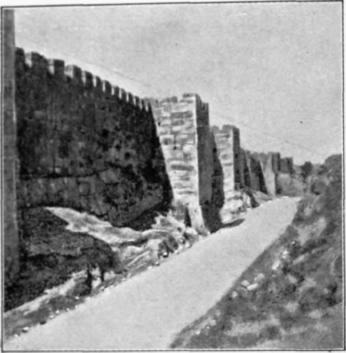
The Old Walls.

The Jaffa Gate.
The first thing we accomplished on the morning after our arrival in the Holy City, was to make the circuit of Jerusalem outside its belt of stone. It is a short excursion, for the area of the Holy City is small. The wall inclosing it is only two and a half miles long, and one can easily walk round the city in an hour. Even in ancient times, although relieved by suburbs, Jerusalem must have been exceedingly compact, and at the period of the Hebrew festivals doubtless was thronged with people. Small though it be, however, a line of fortifications has environed it from the earliest times. History and poetry alike frequently refer to this, as in the Hebrew poet's exultant ode: "Walk about Zion. Go round about her. Count the towers thereof. Mark well her bulwarks."

The Jaffa Gate (From Within).
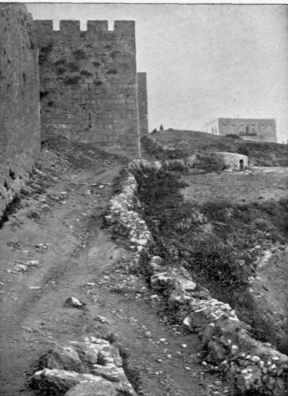
Around The Walls.
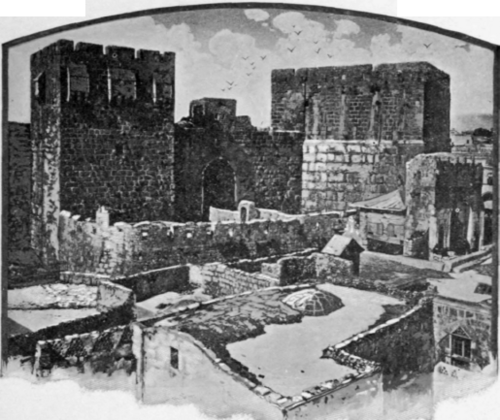
Nor does it seem strange to find the Holy City fortified. Its situation naturally makes of it a fortress. Jerusalem is emphatically a city set upon a hill. It has an altitude of twenty-six hundred feet above the sea. Built on a natural bluff, three sides of it look down on deep ravines which take the place of moats, and would, if filled with water, make the city a peninsula. Had it possessed a valley on the fourth side also, Jerusalem would have been impregnable to ancient modes of warfare. The present walls, which were built by the Sultan Suleiman in 1542, are of course almost worthless now; for one hour's bombardment with modern cannon would make them fall as flat as those of Jericho. Yet, from a distance, Jerusalem still presents the appearance of a fortress; for these old battlements are nearly forty feet in height, and are marked at intervals by projecting towers. Of these the most remarkable, alike for antiquity and strength, is the Tower of David, which was the last point in Jerusalem to yield when the city was captured by the Crusaders; and when the other turrets were destroyed by the Moslems in the thirteenth century, this admirable specimen of mural masonry was spared.
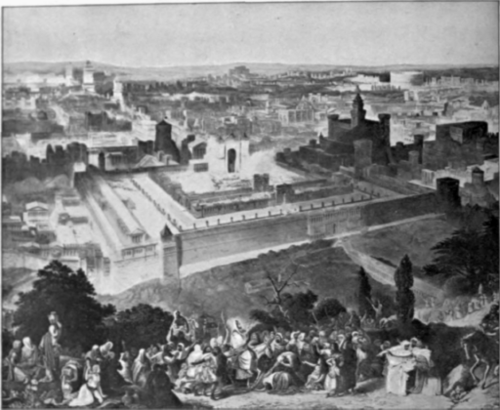
Ancient Jerusalem.
The handsomest of the portals which pierce the walls encircling Jerusalem is the Damascus Gate. It is comparatively modern, as one sees it now, having been built by a Mohammedan caliph about three hundred years ago, but excavations prove that its foundations are of great antiquity. Hence we may lose ourselves in endless speculations as to the famous men who from this point have gone forth from Jerusalem to leave their record on the page of history. Thus, beneath the arch which no doubt rested on these same foundations, Paul may have set forth on his tour of persecution, "breathing out threatenings and slaughter" toward all will fall into the valley yawning to receive them, and thence will be transported to perdition!
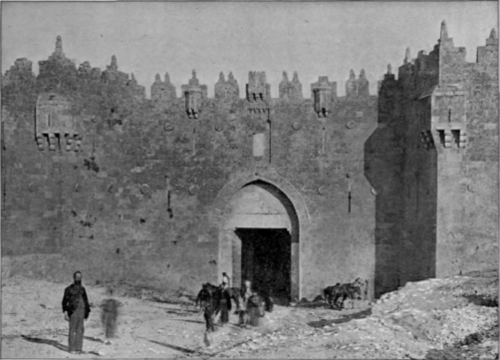
Damascus Gate.
Christians in the north, though destined subsequently, in Damascus, to become a convert to, and the most powerful defender of, the Christian faith. It is positively known, too, that through the Damascus gate, in the year 1099, the brave crusader, Tancred, and his followers made their victorious entry into the city.
In one part of the wall, some thirty feet above the ground, we saw, projecting from the masonry, a small round column which bore a grotesque resemblance to a peg on which a giant might have hung his hat. The Moslems have a tradition that Mohammed will seat himself on this column at the Day of Judgment, to decide the fate of all the people who will then be gathered in the vale below. Why he should choose to sit astride this uncomfortable shaft, instead of occupying a chair on the top of the broad wall, it is difficult to conjecture. Here tradition, nevertheless, assigns his seat, and from this point, it is affirmed, there will be stretched across the intervening valley to the Mount of Olives a bridge as narrow as the blade of a Damascus sword, upon which every one must walk as the decisive test of orthodoxy. It is expected that the followers of the Prophet will glide along this elevated road as safely as an acrobat; but that all others Aside from such absurdities, however, the thoughts suggested by the belt of masonry which surrounds Jerusalem are most impressive. Transfigured by the lurid light of its eventful history, the name Jerusalem, or the "City of Peace," might seem to have been given to it in irony. Of all the cities in the world, Jerusalem is the least entitled to this appellation. The "City of Sieges" would be a more appropriate title, for it is one of the distinctive facts about Jerusalem that it has sustained more terrible and destructive sieges than any city upon earth. It withstood for months many of the finest armies of antiquity; and, when compelled to yield, the pertinacity and valor of its defenders were punished by an amount of cruelty and bloodshed unsurpassed in history. How strange, then, that this Hebrew capital, so deeply stained with blood, should have acquired universal interest, not through some mighty king or warrior, but through the "Prince of Peace" - an unresisting, uncomplaining martyr, who, somewhere on this very hill, besought His Father to forgive His murderers, and gave a memorable lesson in humility by washing His disciples' feet!
Continue to:


